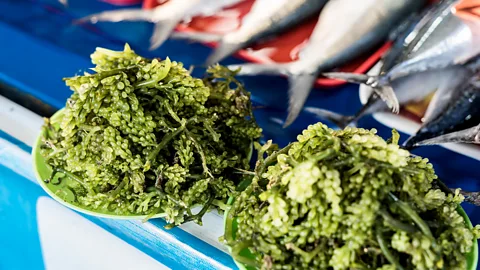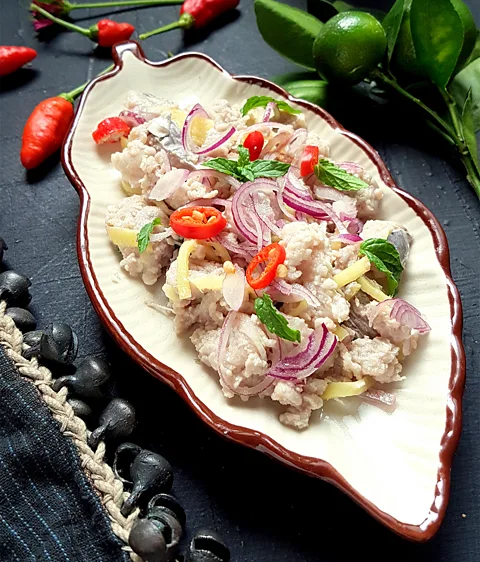'A very special cuisine': Nick Kwek's culinary adventures around Sabah
 Getty Images
Getty ImagesBBC's Discovering the World's Table sees food writer Nick Kwek journey to his ancestral homeland of Sabah in Malaysian Borneo, where he eats pufferfish with the Bajau Laut sea nomads, learns the art of rice wine-making and is given a secret hangover cure.
Pristine turquoise waves lap our boat as we depart the harbourfront in Kota Kinabalu, Sabah's busy state capital, and sail towards a jungle oasis. But it's not an island paradise we're heading for – in fact we're not touching foot on land at all. Instead, we're destined for a cluster of stilted shacks perched above the water's surface some 7km from the shore. The settlement is home to the Bajau Laut, a nomadic community who live most of their lives at sea.
Who better to kickstart my culinary adventure around Sabah with than the Bajau, who eat Malaysia's spectacular seafood for breakfast, lunch and dinner? But first we'll need to catch it. As renowned hunters, they follow the fish, dismantling and rebuilding their makeshift houses as they go, expertly freediving and spearfishing their prey with seemingly supernatural skill.
"They can erect them in as fast as a day," says local tour guide, Emily Chin, who has been working with the Bajau and other Indigenous groups for years. "They're so connected with the sea that they often don't know what to do if they're not on the sea – it's almost like a third arm for them."
Indeed, their bodies have evolved over the years giving them extra-large spleens that act like a biological "scuba tank", allowing them to hold their breath for up to 10 minutes at a time. Meanwhile, my breath has been taken away.
Meet the expert:
Nick Kwek is a food writer, presenter and filmmaker who has travelled the world documenting stories for BBC series including Discovering The World's Table, The Travel Show and Click. He's reported for BBC News, ABC and SBS and contributed to leading food and drink publications.
Kwek grew up into a family of chefs and bakers, before working in some of Scotland's best bars and restaurants.
This is my first time back in my father's homeland, Sabah, in almost two decades. Born and raised in Fife, Scotland, I grew up in my parent's pan-Asian restaurant, surrounded by the billowing smoke of red-hot woks, scorching chilli and fragrant ginger. The exotic flavours and enchanting ingredients of my childhood inspired my passion for food and an insatiable appetite for travel.
To be returning here to discover more about Sabah's traditional dishes, explore its local ingredients and their heritage is an emotional, fantastical experience.
Kwek is a Chinese surname, with my father's side part of Malaysia's largest ethnic minority – the Chinese-Malay community. They live alongside Malays, Indians and Indigenous groups that make up the melting pot that is Malaysia. And it's this uniquely rich cultural diversity that makes for a very special cuisine, bursting with bold, lasting flavours.
Today’s menu is no different – the Bajau are treating me to freshly-caught pufferfish, notoriously poisonous if not prepared correctly and usually served on special occasions such as weddings or family reunions. It's boiled with chilli, garlic, turmeric and fresh calamansi juice, a native citrus with the appearance and sourness of a miniature lime but with the sweet zing of clementine orange. The dish is both hot and tangy, with the fish unexpectedly meaty, reminiscent of monkfish.
Whilst cooking, Chin introduces me to a delicacy adored by the Bajau: latok, a type of seaweed, normally eaten raw. Glistening green globes, these mini bunches of "sea grapes" pop on your tongue, releasing a salty, juicy, refreshing essence of the sea. This so-called green caviar is gaining popularity across Southeast Asia as a healthy and nutritious snack.
Back on dry land, it's an ingredient celebrated by chef Raphael Lee, of high-end eatery OITOM in downtown Kota Kinabalu. Originally from Sabah, he moved to Melbourne, Australia, to train in refined cooking techniques before returning to introduce a new fine dining concept to the city, catering to its burgeoning middle class and international visitors.
"Oitom means 'black' in Kadazan-Dusun [the language of Sabah's largest ethnic group]", Lee tells me. "We are championing heritage cuisines through the lens of the culinary world." Named in honour of Lee's heritage, the restaurant has a dark-black interior that acts as a stage so his colourful plates can shine.
Today we're preparing a raw white fish salad called hinava, a traditional cured dish of the Kadazan-Dusun tribes. Akin to ceviche, it comprises grouper, fresh chilli, ginger, shallots, calamansi juice and bambangan (an indigenous wild mango). But Lee's modern take on the classic dish involves homemade kombucha, strawberries foraged from the foothills of Mount Kinabalu and latok.
"We have around 33 tribes in Borneo and each prepares their hinava differently. Some use vinegar, some use bambangan seed. Food is all about cross-culture, and of course whilst we want to treasure the authenticity of our cuisine, for its growth, it needs innovation as well," he says.
 Getty Images
Getty ImagesLee's version is delicately presented, with each element tweezered into place and the taste is softer, smoother and more complex than the original.
Seafood is undeniably the star of the show in Sabah. Coastal towns sprawl with fish markets, while restaurants and food courts have tanks teaming with live, freshly caught grouper, crabs, lobsters, prawns and clams. These ingredients play a leading role in the country's signature specialities like the lusciously spicy curry laksa, char kway teoh (a gloriously fatty fried noodle mix) and the iconic butter prawns – delightfully crispy yet wondrously creamy, served in the shell.
But as well as sublime seafood surrounding the huge island of Borneo (the third largest island in the world at around 290,000 sq km), inland is another staple of the modern Malaysian diet: rice.
More like this:
• Mandy Yin's Sarawak white chicken
Popularised with the arrival of migrants from China, India, Sumatra and Thailand during British colonialism in the 19th Century, rice takes centre stage for the country's national dish, nasi lemak. A meal made of several parts but almost always coconut rice, boiled eggs, cucumber, sambal sauce and tiny dried fish known as "bilis". (Try it with beef rendang – a dry lemongrass and coconut stew – you won't regret it.)
Two hours' drive over the hills into the mountain valley of Keningau belies a sea of green fields – pastures of rice paddies as far as the eye can see. Out in the blistering Sun I meet village chief Mami Ita whose family has been growing rice here and making traditional tapai (rice wine) for generations. She welcomes me to her home where she teaches me how it's made.
We start by building a fire and boiling rice that's leftover from last year's harvest and has had time to sufficiently harden. "It's a family activity," she tells me, something sacred to bond over. In addition to love, the secret ingredient here is ragi, a yeast formed by hand. The caressing of the yeast helps form its unique flavour profile as the scent and spirit of its handler becomes solidified within. Each family's brew produces its own distinct taste.
"You don't touch chilli or lemon for two weeks before handling the ragi," warns Mami Ita, whose yeast starter used today was her grandmother's.
Instead of a wooden barrel, the wine is matured inside a clay pot known as a tajau, but it's left to age without water. Only upon opening a tajau several months later is water added and the newly infused wine ready to drink. Before I sip, Mami Ita lets me in on a secret ritual to keep the hangover demons at bay.
"Place your finger into the wine, then touch it against your forehead and then into your belly button and say "Tuka Tuka!" To my disbelief, it worked!
Tapai is having a moment in Borneo. It's being reimagined at Limau & Linen, a contemporary restaurant and lounge in Kota Kinabalu's upmarket Signal Hill neighbourhood, where proprietor and executive chef Linn Yong mixes rice wine with coconut syrup and pineapple juice before garnishing the cocktail with local mountain flowers.
Yong is keen to convey that Malaysia's cuisine is a reflection of its people. She's crafted a dish that honours her nation's diversity yet togetherness: the "tajau treasure community pie". A confit of smoked octopus, scallops and shrimp, rice, rice wine and fish stock are combined in a tajau and topped with a puff pastry lid. It's a celebration of Sabah's bounty, intended to be enjoyed together.
"Behind every restaurant is a community of farmers and customers. For me it's like breaking bread with the people we love," says Yong.
As the pie reaches the table and Yong makes a speech about her creation's genesis, steam rises up around us, filling the room with a warm comforting aroma that brings me home. A befitting finale to our journey of discovery, reconnection and the indelible impact of cultural traditions.
--
If you liked this story, sign up for The Essential List newsletter – a handpicked selection of features, videos and can't-miss news, delivered to your inbox twice a week.
